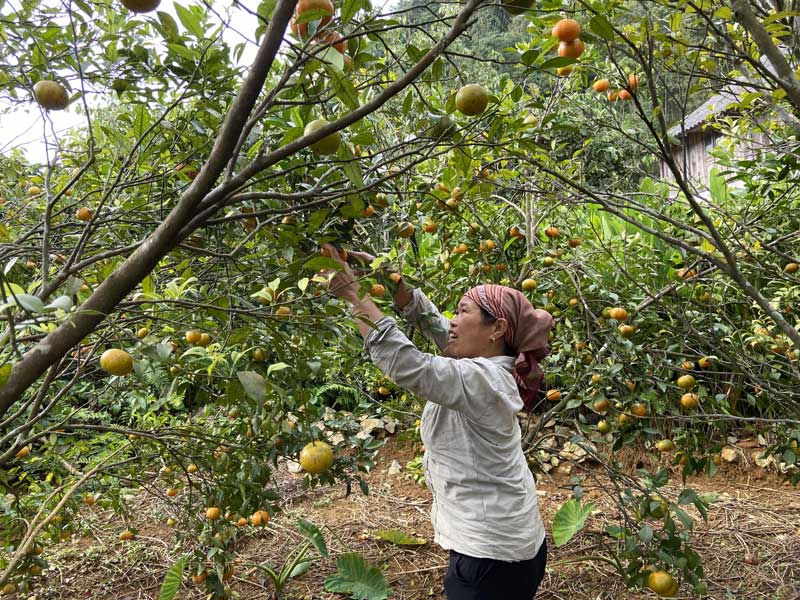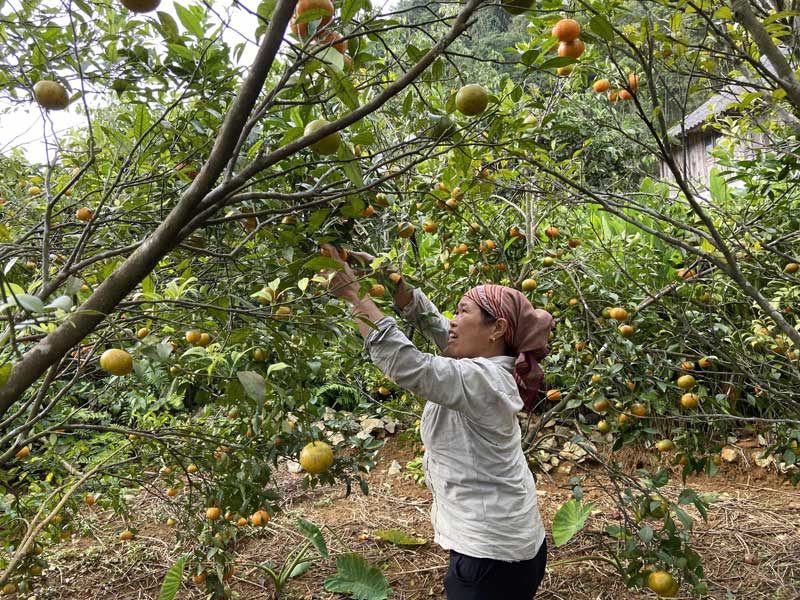
(HBO) – Over the last four years, farmers across Thung Khe commune (Mai Chau district) start bustling round to harvest tangerine when October arrives. The fruit, which is thin-skinned and very sweet, is usually in season from October through late December.
Growers here
only use safe, natural farm inputs with no harmful chemicals on tangerine farms.
Though tangerine trees in Thung Khe began to bear fruits only four years ago, the trees have proved their
high economic value, providing extra income to the locals.
 Farmers in Thung Khe village, Thung
Khe commune (Mai Chau) pick tangerines in their gardens.
Farmers in Thung Khe village, Thung
Khe commune (Mai Chau) pick tangerines in their gardens.
Since 2013,
authority of Thung Khe commune has encouraged local farmers to shift from
low-yield crops to tangerine, which suits the local soil and
climate conditions.
The farmers
has bought saplings from
other localities, such as Hoa Binh’s Cao Phong district and Ha Giang province and
later been trained by local agriculture promotion officals on how to use
fertiliser and take care of the tangerine.
Biofertiliser
and natural farm inputs are used
in all tangerine areas so the tangerine has been favoured by consumers.
At this time,
tangerines are being sold by farmers along Highway 6. It is also purchased in a
large quantity by traders from Mai Chau, Tan Lac, Hoa Binh City. The tangerines
fetch 20,000 VND per kg at the farm and 25,000 – 30,000 VND per kg at the
market.
Tangerine
areas in the commune have been expanded to 5 hectares, including 2 hectares being
in harvest season, said Chairman of the Thung Khe commune’s People’s Committee
Ha Van Hung. Many local households have got better off thanks to the
fruit, earning 60 million – 100
million VND annually.
The commune
plans to continue encouraging more farmers to shift to high-yield crops like
tangerine and provide technical training for farmers to boost the fruit’s yield and quality.
It will also
coordinate with local authorities and agencies to seek broader market for the
tangerine./.
Since the beginning of this year, under the direction of the Department of Agriculture and Environment, the Sub-Department of Agricultural, Forestry, and Fishery Product Quality Management has strengthened the integration of the professional activities to promote and guide the organizations and individuals in the production and trading of agricultural, forestry, and fishery products to comply with the legal regulations regarding the use of chemicals, pesticides and veterinary medicines in crop cultivation, livestock farming and aquaculture. They also provide guidance to processing and manufacturing establishments on keeping the records to trace the product origins and using food additives from the approved list according to the regulations.
Hoa Binh province saw a significant rise in state budget revenue in the first two months of 2025, heard a meeting chaired by Vice Chairman of the provincial People’s Committee Quach Tat Liem.
Ha Thi Ha Chi, a 26-year-old graduate in law, has taken an unconventional path by returning to her hometown in Mai Chau district to establish the Tong Dau Cooperative, creating stable jobs for local women and bringing Thai ethnic brocade weaving to the global market.
As the Lunar New Year 2025 approached, pork prices surged, creating a profitable season for farmers in Tan Vinh commune, Luong Son district. Taking advantage of the rising demand, Can Minh Son, a farmer from Coi hamlet, sold over 30 pigs at 69,000 VND/kg, each weighing more than 100 kg. After deducting expenses, his family earned a profit of over 50 million VND.
alternate member of the Central Party Committee, Secretary of the Hoa Binh provincial Party Committee Nguyen Phi Long on March 5 had a working session with Yan Jiehe, Founder and Chairman of the China Pacific Construction Group, one of China's largest private corporations in the field of transport infrastructure. Deputy Secretary of the provincial Party Committee, Chairman of the provincial People's Committee Bui Duc Hinh and leaders of provincial departments and sectors also attended the working session.
The electronic printed circuit board (PCB) manufacturing and processing plant of Japan’s Meiko Group, located at Da River Left Bank Industrial Park in Hoa Binh city with a total investment of over 200 million USD, is expected to create thousands of jobs and make a significant contribution to the local budget.



 Farmers in Thung Khe village, Thung
Khe commune (Mai Chau) pick tangerines in their gardens.
Farmers in Thung Khe village, Thung
Khe commune (Mai Chau) pick tangerines in their gardens.